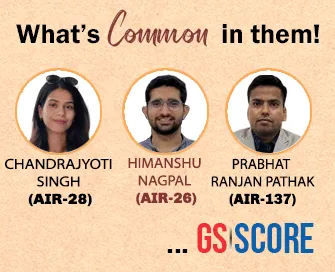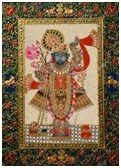

Context
Recently, a new book features 60 miniature works from the collection of the late Gokal Lal Mehta.
About
About Nathdwara paintings:
- Nathadwara is a small town some 40 kilometres north of the Udaipur city in Rajasthan.
- The Nathdwara School of Painting is a subset of Mewar School and is seen as an important school in 17th and 18th century.
- Nathadwara is the present headquarters of the Pushti Margiya Vaishnavite cult.
- The art practice includes haveli-painting traditions like pichhvais—textile wall hangings as the backdrop of Srinathji, and other embroidered designs and murals
- Nathdwara paintings are of different sub-styles of which Pichhwai paintings are the most popular.
- The word Pichhwai derives from the Sanskrit words pich meaning back and wais meaning hanging.
- These paintings are cloth paintings hung behind the image of the Hindu god Shrinathji.

Styles of Rajasthani Painting:
Starting from the 16th century, when the Rajasthani Painting originated, the main schools emerged, including:
- Mewar School: Chavand, Nathdwara, Devgarh, Udaipur and Sawar
- Marwar School: Jodhpur, Kishangarh, Bikaner, Nagaur, Pali and Ghanerao styles
- Hadoti School: Kota, Bundi and Jhalawar styles
- Dhundar School: Amber, Jaipur, Shekhawati and Uniara styles
About Pushtimarg:
- Pushtimarg is a form of Krishna worship or adoration as founded by Shri Vallabhacharya (1479–1531 AD), a Telugu Vaidiki Brahmana, who was also the propounder of Shuddha-Advaita or pure nondualism.
- Vallabhacharya was a contemporary of Sri Krishnadeva Raya of the Vijayanagara Empire, and attended his court to participate in a prolonged debate on the merits and demerits of Dvaita and Advaita philosophies.
- Pushtimarg is a variant of the Bhaktimarg or the path of devotion, which is mentioned in the Bhagavadgita as the direct and the simplest approach to achieve liberation.
- It centers around pushti bhakti.
- Pushti means nourishing and bhakti means devotion.
- Pushti bhakti means nourishing the soul with divine love and happiness through devotion and selfless service to Lord Krishna, the supreme deity.
- Unlike the nondualism (Advaita) of Shankaracharya, Vallabhacharya’s pure nondualism (Shuddha Advaita) regards the world as the creation of Krishna are real, not an illusion.
- It is the physical or material aspect of Krishna himself.
- All the deities who are part of God’s creation arise in him and exist in him.
- Therefore, as suggested in the Bhagavadgita, one should worship Krishna only to attain him rather than worshipping the lower gods, demi-gods, etc.

